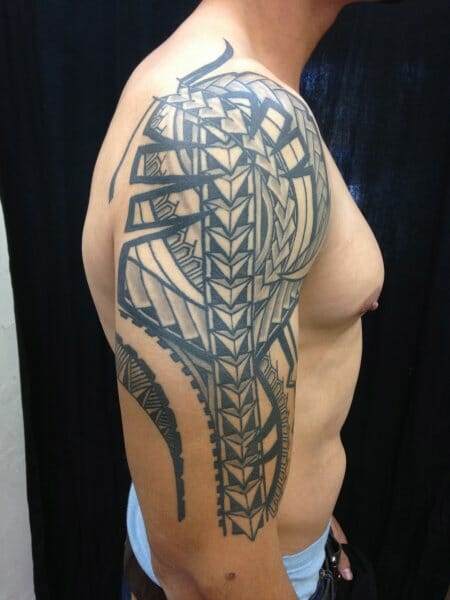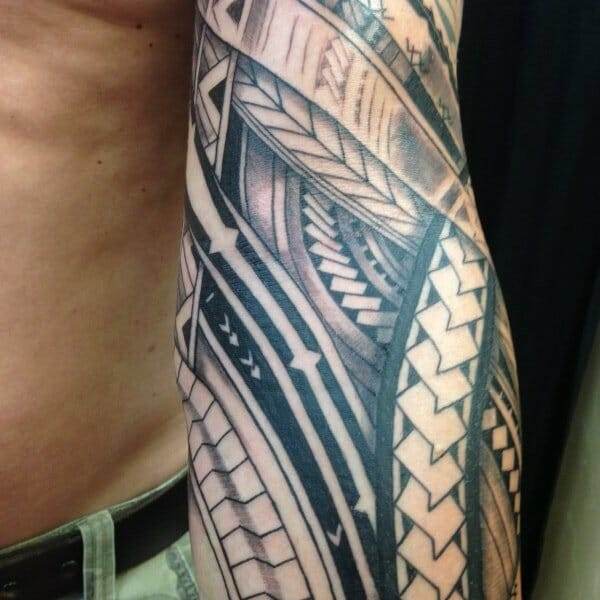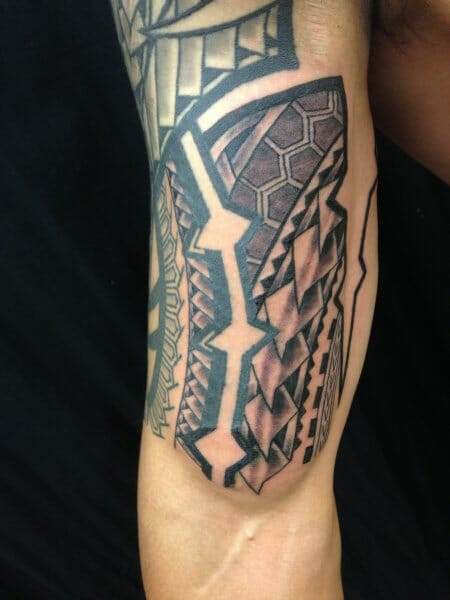Polynesian tattoos hold immense cultural significance in Pacific Islander culture. These tattoos are not just a form of body art, but they also serve as a means of expressing one’s identity, heritage, and spirituality. In this blog post, we will explore the origins, artistry, symbolism, and role of Polynesian tattoos in society and culture. We will also delve into the spiritual and mystical beliefs associated with these tattoos, as well as the practices and customs surrounding their creation. Furthermore, we will examine the influence of Polynesian tattoos on contemporary tattoo art and discuss the connection between body art and self-expression. Finally, we will address the challenges and opportunities in preserving this rich cultural heritage.
The Origins of Polynesian Tattooing: A Brief History
Polynesian tattooing has a long and rich history that dates back thousands of years. It is believed to have originated in the islands of Polynesia, which include Samoa, Tonga, Tahiti, and Hawaii. The art of tattooing was deeply ingrained in the culture and traditions of these islands, serving as a rite of passage, a form of protection, and a way to honor one’s ancestors.
There are different styles of Polynesian tattoos that vary from island to island. For example, Samoan tattoos are characterized by intricate geometric patterns that cover large areas of the body. These tattoos are traditionally done using a manual technique called “tatau,” where the artist uses a comb-like tool to tap ink into the skin. On the other hand, Maori tattoos from New Zealand feature bold black lines and curved shapes known as “koru.” These tattoos often depict ancestral symbols and tell stories of the wearer’s heritage.
The Art of Polynesian Tattooing: Techniques and Tools Used
Traditional Polynesian tattooing techniques involve using natural tools and materials. The process begins with the artist creating a design, which is often customized to reflect the individual’s personal story or cultural heritage. The design is then transferred onto the skin using a stencil or freehand technique. The artist then uses a comb-like tool made from bone, shell, or wood to tap ink into the skin. This process can be painful and time-consuming, as the artist must carefully create each line and shape.
In modern Polynesian tattooing, electric tattoo machines are often used instead of traditional hand tools. These machines allow for faster and more precise tattooing, but some artists still prefer to use the traditional manual technique for its cultural significance and authenticity. Additionally, modern tattoo inks are used, which come in a wide range of colors and shades to create vibrant and detailed designs.
Symbolism and Meanings of Polynesian Tattoo Designs

Polynesian tattoo designs are rich in symbolism and meaning. Each symbol used in these tattoos represents something significant, such as strength, courage, family, or spirituality. For example, the turtle symbolizes longevity and protection, while the shark tooth represents strength and adaptability. Other common symbols include waves, suns, birds, and tribal patterns.
The meanings behind Polynesian tattoo designs can vary depending on the specific culture and island they come from. For example, in Samoan culture, tattoos are seen as a way to honor one’s ancestors and connect with their spiritual guidance. In Maori culture, tattoos serve as a visual representation of one’s genealogy and social status.
The Role of Polynesian Tattoos in Society and Culture
Polynesian tattoos play a significant role in Pacific Islander society and culture. They are not just seen as a form of body art but are deeply intertwined with social, cultural, and spiritual aspects of life. These tattoos are often worn to mark important milestones in a person’s life, such as coming of age ceremonies, weddings, or funerals. They also serve as a way to express one’s identity, heritage, and connection to their community.
In Pacific Islander society, Polynesian tattoos are highly respected and admired. They are seen as a sign of strength, courage, and wisdom. The wearing of these tattoos can also indicate a person’s social status or rank within their community. Additionally, Polynesian tattoos are often used as a form of protection, believed to ward off evil spirits and bring good luck.
The Spiritual and Mystical Beliefs Associated with Polynesian Tattoos
Polynesian tattoos are deeply rooted in spiritual and mystical beliefs. In many Pacific Islander cultures, it is believed that these tattoos have the power to connect the wearer with their ancestors and the spiritual realm. The process of getting a tattoo is seen as a sacred ritual, where the artist channels the energy of the ancestors to create a design that will protect and guide the wearer throughout their life.
The symbols used in Polynesian tattoos often have spiritual meanings. For example, the sun symbolizes life and vitality, while the ocean represents the source of all life and creation. These symbols are believed to carry the mana (spiritual power) of the ancestors and can provide guidance and protection to the wearer.
Polynesian Tattooing Traditions: Practices and Customs
Polynesian tattooing is steeped in rich traditions, practices, and customs. The process of getting a tattoo is seen as a sacred journey that requires careful preparation and respect for cultural protocols. Before getting a tattoo, individuals often undergo a period of purification and spiritual preparation. This may involve fasting, prayer, or other rituals to cleanse the body and mind.
During the tattooing process, there are specific customs that must be followed. For example, it is customary for the person getting the tattoo to remain still and silent as a sign of respect for the artist and the spiritual significance of the tattoo. It is also common for family members or close friends to be present during the tattooing process to provide support and witness the transformation.
After getting a tattoo, there are often post-tattooing rituals and practices that must be observed. These may include avoiding certain foods or activities, wearing specific clothing, or participating in ceremonies to honor the tattoo and its spiritual significance.
The Influence of Polynesian Tattoos on Contemporary Tattoo Art
Polynesian tattoos have had a significant influence on contemporary tattoo art around the world. The bold lines, intricate patterns, and symbolic meanings of Polynesian tattoos have inspired many tattoo artists to incorporate these elements into their own designs. This has led to the emergence of a distinct style known as “Polynesian-inspired” or “tribal” tattoos.
Contemporary Polynesian-inspired tattoos often feature similar geometric patterns, symbols, and motifs found in traditional Polynesian tattoos. However, they may also incorporate elements from other tattoo traditions or personal artistic styles. These tattoos are not limited to people of Pacific Islander descent but are worn by individuals from diverse backgrounds who appreciate the beauty and cultural significance of Polynesian art.
Polynesian Tattoos and Identity: The Connection between Body Art and Self-Expression
Polynesian tattoos play a crucial role in shaping one’s identity and self-expression. For many Pacific Islanders, these tattoos are a way to honor their heritage, connect with their ancestors, and express their cultural identity. The symbols and designs used in Polynesian tattoos can tell a person’s life story, represent their values and beliefs, or serve as a reminder of their roots.
Polynesian tattoos also provide a sense of belonging and community. They serve as a visual marker that identifies individuals as part of a specific culture or community. These tattoos can create a sense of pride and unity among Pacific Islanders, as they share a common cultural heritage and identity.
The Preservation of Polynesian Tattooing: Challenges and Opportunities
The preservation of Polynesian tattooing faces several challenges in the modern world. One of the main challenges is the loss of traditional knowledge and techniques. As Western influences continue to permeate Pacific Islander culture, younger generations may be less inclined to learn and practice the art of Polynesian tattooing. This poses a threat to the preservation of this rich cultural heritage.
However, there are also opportunities for preserving Polynesian tattooing. Many organizations and initiatives are working to document and revive traditional tattooing practices. These efforts include cultural festivals, workshops, and educational programs that aim to pass on the knowledge and skills of Polynesian tattooing to future generations. Additionally, the growing popularity of Polynesian-inspired tattoos among people from diverse backgrounds has sparked interest in learning about the cultural significance and history behind these tattoos.

Celebrating the Rich Cultural Heritage of Polynesian Tattoos
In conclusion, Polynesian tattoos hold immense cultural significance in Pacific Islander culture. They are not just a form of body art but serve as a means of expressing one’s identity, heritage, and spirituality. The artistry, symbolism, and practices associated with Polynesian tattooing are deeply rooted in tradition and have been passed down through generations. It is crucial to celebrate and preserve this rich cultural heritage by supporting initiatives that promote the knowledge and practice of Polynesian tattooing. By doing so, we can ensure that future generations continue to appreciate and honor the cultural significance of these tattoos.



